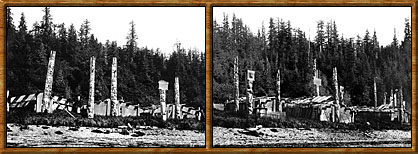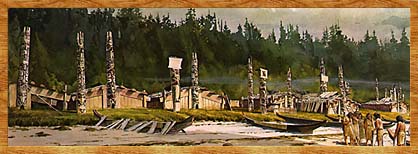 
|
Cumshewa

The village of Cumshewa is on the northern shore of Cumshewa Inlet, an hour's paddle from Skedans. In 1840, the village had about twenty houses and slightly fewer than three hundred inhabitants, who belonged to three closely related Eagle lineages.

Cumshewa was an anglicized version of the name of the town chief, Gomshewah, a Heiltsuk word meaning "rich at the mouth of the river." This alludes to the teeming life at a river mouth where seagulls, seals and killer whales congregate to feed upon the salmon that pool there prior to making their spawning run up the river. When the first European ships with their white sails arrived on the coast, the Haida compared them to the flocks of seagulls at spawning time and gave the name Cumshewa to the white people associated with this apparition. The Haida name for the village was Thlinul, anglicized as Tlkinool by John Work, who carried out the first census of the Haida for the Hudson's Bay Company in 1839; the Tsimshian called the village Kit-ta-was.
Joseph Ingraham's journals of 1791 and 1792 record numerous trading activities with Chief Cumshewa and his people, although Ingraham did not leave his ship: "The people of these Isles in generall possess a truly merchantile spirit but none more so than the tribe of Cummashawaa for they will not part with a single skin till they had exerted their utmost to obtain the best price for it."
Reverend Jonathan Green, who visited Cumshewa in 1829 when there was a war in progress between that village and the Tsimshian town of Kitkatla, did not leave his ship either:
We came down opposite Kumshewa village, and several of the Indians came off to see us. This is the tribe, several of whom were killed by the Shebasha men. Some of the sufferers of that quarrel were on board. One lost a child, another a sister, another his wife, besides receiving a wound himself. Their badge of mourning is a face painted horribly black, with their hair cut very short.
George M. Dawson was the first outside visitor to actually enter the village:
The village generally known as Cumshewas is situated in a small bay facing toward the open sea, but about two miles [3.2 km] within the inlet to which the same name has been applied. The outer point of the bay is formed by a little rock islet, which is connected to the main shore by a beach at low tide . . . There are now standing here twelve or fourteen houses, several of them quite ruinous, with over twenty-five carved posts. The population is quite small, this place having suffered much from the causes to which the decrease in numbers of the natives have already been referred.
Cumshewa was occupied until 1905, when Methodist missionaries encouraged the remaining few inhabitants to move to Skidegate.
|